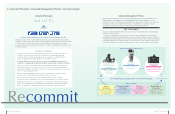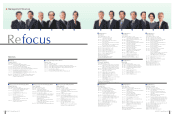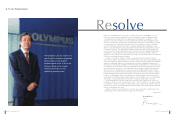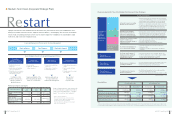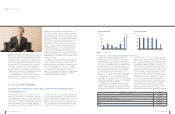Olympus 2013 Annual Report Download - page 14
Download and view the complete annual report
Please find page 14 of the 2013 Olympus annual report below. You can navigate through the pages in the report by either clicking on the pages listed below, or by using the keyword search tool below to find specific information within the annual report.
24 OLYMPUS Annual Report 2013 25OLYMPUS Annual Report 2013
The Creation of a New Olympus and Future Growth—Conversation with Analysts
Results during First Year under New Management System and Future Challenges
Hari A number of strategic decisions have been
made over the year that followed the institution of the new
management system headed by President Sasa. I think one
of the important changes over this period is the structural
reforms that have been taken. The Company has signifi ed that
it will increase its emphasis on the Medical Business. It also
sold ITX Corporation, which operated the non-core Information
& Communication Business. This move was received very
positively, as demonstrated by the stock market’s reaction on
the day after the sale. The decision to restructure the Imaging
Business was also well received by the market, refl ecting the
belief that Olympus was orienting itself in the right direction.
Another important change has to do with the balance sheet.
Previously, it seemed as though Olympus was focused
primarily on profi ts and losses, but now the Company has
turned its eye to the balance sheet. While progress on this front
is still slow in comparison to competitors, Olympus is actively
working to repay debt and improve its balance sheet in
other ways, which I believe is a very important change.
Going forward, I believe a challenge that must be
addressed will be developing appropriate growth strategies for
the Medical Business. The Company’s fl exible endoscopes
have an unmatched position in their market, which is ripe with
growth opportunities. As such, operations in this business
will likely grow with little effort over the foreseeable future.
However, Olympus still lags behind the competition in the
surgical device fi eld and must overcome challenges in this
area. Structural reforms are important, but, in the end, the
value that the market attributes to Olympus will be determined
by the growth potential of its Medical Business. I therefore
hope you will focus on ensuring the growth of this business.
Nakanomyo Change over the past year has been substantial.
The Company’s management is showing a clear stance
toward listening to the input of the market. I also believe that
the outside directors and other members of the Board of
Directors are engaging in very free discussion. In these ways,
the Company is gradually developing governance systems
that can be deemed as ideal. I hope that governance reforms
of this type will continue going forward. It is also my
understanding that you will take a fl exible approach toward
conditions in the Imaging Business. The Medical Business
will likely be solid over the next three to fi ve years. However,
this is not a given. While not a trend limited to endoscopes,
the quality of products in the low-to-middle range is rapidly
improving, and competition is intensifying for products in
the middle-to-high range in terms of price as well as other
considerations. We cannot deny the possibility of this trend
advancing further for endoscopes. If this occurs, I am
worried that the Company’s product mix may prove less
competitive. A number of Japanese technology companies
are losing to such trends. Where others fail, I want Olympus
to continue to succeed with unrivaled strength, and I hope
that you will develop strategies that allow this to be
accomplished.
Sasa Addressing that point, similarly to magnetic
resonance imaging (MRI) and computed tomography (CT)
scanners, endoscopes cannot simply be installed and left
for use. All of these devices are incredibly precise pieces of
equipment, and they must constantly undergo maintenance.
Endoscopes, in particular, are inserted directly into a patient’s
body and, therefore, have the potential to lead to a serious
medical accident if they malfunction to even the smallest
degree. For this reason, maintenance, repair, and service
structures are absolutely essential. These systems present one
of the key strengths for enabling Olympus to maintain its
top share of the market. If other companies were to attempt to
provide these systems, they would have to incur a somewhat
prohibitive level of costs. In this manner, there is a very high
hurdle for participation in this business. The extent to which
Olympus is to deal in the low-to-middle range will be decided
on a strategic basis going forward. I have a strong desire
to accelerate the development of the Medical Business.
Presently, we have medium-term product plans and business
strategies in place that will cover us for the next fi ve or six
years. As such, I have no worries in this regard. Rather, at the
moment, I think we need to invest more in sales and
marketing. The main concern for these areas lies further down
the line. As you stated, accelerating growth in the Medical
Business will require a strategy that takes us one step further.
This is actually an area we have chosen not to address in the
medium-term vision. I therefore realize that one of the issues
management must tackle next will be the development of
such a strategy. For example, we have to be able to clearly
explain what the fi gure for elimination or corporate represents
for the Company. The ability to provide such explanations is
something we must work to accomplish.
Moriyama Management’s ability to escape for the fi rst time
from the plans targeting growth in the Imaging Business
through the pursuit of sales expansion could be considered
one accomplishment of this year. A concern for the future is
whether or not the Company can institute profi t structure
reforms that take it further than simply meeting its goals.
I think this is an area that markets are watching carefully.
Implementing such reforms will entail strengthening
monitoring functions. Is management now actually able
to urge business divisions to rethink the plans they have
developed? Also, is it now possible for plans to be changed
swiftly in the middle of fi scal years?
Sasa Let me start by saying that we are already
conducting periodic monitoring, and these efforts are not
limited to the Imaging Business. Based on such efforts,
management discusses the conditions of individual businesses
while also taking a more comprehensive view. In addition,
we monitor the Imaging Business on an individual basis.
The business division is asked to report sales data, how it
interprets this data, and what its future policies are. Further, we
expect the division to inform us about the risks that are present
as well as any delays in development or production. At the
same time, we discuss how these matters are being interpreted
by the corporate divisions conducting the monitoring and how
we should proceed. Based on such considerations, we work to
implement necessary measures when they are needed, and
we do this on a Groupwide basis if appropriate. The Board
of Directors as well has been instructed to maintain an
understanding of the risks in the Imaging Business and to think
of ways that these risks can be addressed by the Group.
As such, the Board of Directors also plays a role in
performing checks and balances and in supervision.
Nakanomyo Personally, I do not feel completely at rest with
regard to the Imaging Business. The substantial reduction in
sales volume targets is a signifi cant shift, but I think it is still
possible that these targets will not be met and losses will be
recorded as a result. I can understand why you wish to continue
the Imaging Business, and I feel that there is no need to
withdraw. Still, is there any way you could further reduce risks?
Sasa Over the past year, we have evaluated all
possible options. This issue was discussed in depth, and
we received advice from the outside directors before fi nally
arriving at our decision. However, as the operating
environment changes, we will of course have to reevaluate
the path we have chosen, and we are thus prepared to take
additional steps as necessitated by the conditions we face.
As you say, controlling risks, including those related to
mirrorless cameras, will be an important task going forward.
Moreover, if we are unable to complete the shift to
mirrorless cameras, the very continuation of the Imaging
Business will be threatened. Some risks can be addressed
by reducing SG&A expenses while others vary in conjunction
with sales. I do not think I have to list off the risks we face.
Moriyama I believe the degree to which you can
communicate the changes in corporate governance systems
on a global basis will be an important consideration. There
is a limit to which the Company’s efforts can be seen and
understood from outside, and I therefore think Olympus
should work to communicate these efforts more. Once a
company has lost the trust of the market, it must work harder
than other companies if it hopes to regain its former level of
trust. One way Olympus might accomplish this is by taking
steps that other Japanese companies do not. For example,
the Company could disclose compensation amounts for all
corporate offi cers, show the market everything that can be
shown. In other words, if the Company goes forward where
others hesitate, I think its efforts will inspire investors and
others in the market to rethink their evaluation of Olympus.
Sasa This is a consideration, and it might be possible
to disclose the activities of the Compensation Committee
and the Nominating Committee.
Hari In your daily work as president, do you devote
more time to securing profi tability or to formulating growth
strategies centered on the Medical Business? I expect that
you plan to shift your focus to growth strategies over the
medium-to-long term. Is this the case?
Sasa Just as you say, one of my main focuses is how
we will restructure our operations. The Medical Business
will form a central pillar of our future operations. As such,
it will be important to consider the extent to which we
can accelerate growth in that business while effectively
controlling costs in other businesses. For this reason, I think
it is critical that we develop a clear medium-to-long-term
direction for the Medical Business. This will entail deciding
how we will position human resources and allocate
management resources. Going forward, I hope to devote
my time as president to addressing these tasks.
Nakanomyo Where will the life science operations be
positioned in the future? Will you pursue coordination with
the Medical Business?
Sasa Such coordination is a possibility. However,
we have to be aware of the lack of profi tability in our life
science operations, regardless of the fact Olympus
commands the largest share of the market for biological
microscopes. We were successful in generating profi t by
reorganizing production sites and implementing other
structural reforms, but the profi tability issues still remain.
Competitors are surely facing a similar situation.
Nevertheless, I believe that microscopes are absolutely
necessary to the world. I recognize the importance of
microscopes, and I think it is possible to improve profi tability.
Therefore, I am encouraging business divisions to continue
these operations.



